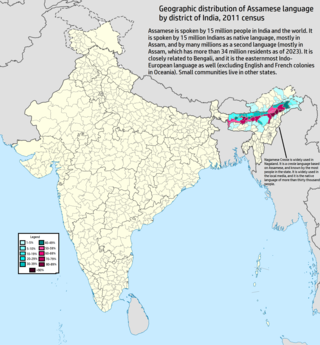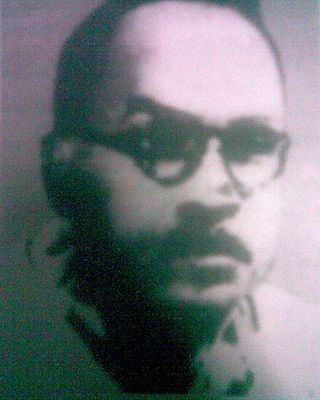Related Research Articles

Assam is a state in northeastern India, south of the eastern Himalayas along the Brahmaputra and Barak River valleys. Assam covers an area of 78,438 km2 (30,285 sq mi). The state is bordered by Bhutan and Arunachal Pradesh to the north; Nagaland and Manipur to the east; Meghalaya, Tripura, Mizoram and Bangladesh to the south; and West Bengal to the west via the Siliguri Corridor, a 22-kilometre-wide (14 mi) strip of land that connects the state to the rest of India. Assamese and Boro are the official languages of Assam, while Bengali is an additional official language in the Barak Valley.

Assamese, also Asamiya, is an Indo-Aryan language spoken mainly in the north-eastern Indian state of Assam, where it is an official language, and it serves as a lingua franca of the wider region. The easternmost Indo-Iranian language, it has over 15 million speakers according to Ethnologue.

The Bihu dance is an indigenous folk dance from the Indian state of Assam related to the Bihu festival and an important part of Assamese culture. Performed in a group, the Bihu dancers are usually young men and women, and the dancing style is characterized by brisk steps, and rapid hand movements. The traditional costume of dancers is colorful and centered round the red color theme, signifying joy and vigour. It is a festival of joy and happiness.

Kamarupi Prakrit is the postulated Middle Indo-Aryan (MIA) Prakrit language used in ancient Kamarupa. This language is the historical ancestor of the Kamatapuri lects and the modern Assamese language; and can be dated prior to 1250 CE, when the proto-Kamta language, the parent of the Kamatapuri lects, began to develop. Though not substantially proven, the existence of the language that predated the Kamatapuri lects and modern Assamese is widely believed to be descended from it.

The Assamese alphabet is a writing system of the Assamese language and is a part of the Bengali-Assamese script. This script was also used in Assam and nearby regions for Sanskrit as well as other languages such as Bodo, Khasi, Mising, Jaintia etc. It evolved from Kamarupi script. The current form of the script has seen continuous development from the 5th-century Umachal/Nagajari-Khanikargaon rock inscriptions written in an eastern variety of the Gupta script, adopting significant traits from the Siddhaṃ script in the 7th century. By the 17th century three styles of Assamese alphabets could be identified that converged to the standard script following typesetting required for printing. The present standard is identical to the Bengali alphabet except for two letters, ৰ (ro) and ৱ (vo); and the letter ক্ষ (khya) has evolved into an individual consonant by itself with its own phonetic quality whereas in the Bengali alphabet it is a conjunct of two letters.

Buranjis are a class of historical chronicles and manuscripts associated with the Ahom kingdom written initially in Ahom Language and later in Assamese language as well. The Buranjis are an example of historical literature which is rare in India. They bear resemblance to Southeast Asian traditions of historical literature. The Buranjis are generally found in manuscript form, though a number of these manuscripts have been compiled and published, especially in the Assamese language.

Boro, also rendered Bodo, is a Sino-Tibetan language spoken primarily by the Boro people of India, Nepal and Bangladesh. It is an official language of the Indian state of Assam, predominantly spoken in the Bodoland Territorial Region. It is also one of the twenty-two languages listed in the Eighth Schedule of the Constitution of India. Since 1975 the language has been written using the Devanagari script. It was formerly written using Latin and Eastern-Nagari scripts. Some scholars have suggested that the language used to have its own now lost script known as Deodhai.

Goalpariya is a group of Indo-Aryan dialects spoken in the Goalpara region of Assam, India. Along with Kamrupi, they form the western group of Assamese dialects. The North Bengali dialect is situated to its west, amidst a number of Tibeto-Burman speech communities. The basic characteristic of the Goalpariya is that it is a composite one into which words of different concerns and regions have been amalgamated. Deshi people speak this language and there are around 20 lakhs people.

Assamese literature is the entire corpus of poetry, novels, short stories, plays, documents and other writings in the Assamese language. It also includes the literary works in the older forms of the language during its evolution to the contemporary form and its cultural heritage and tradition. The literary heritage of the Assamese language can be traced back to the c. 9-10th century in the Charyapada, where the earliest elements of the language can be discerned.

Jyoti Prasad Agarwala was a noted Indian playwright, songwriter, poet, writer and film maker from Assam. He was considered as Assamese cultural icon, deeply revered for his creative vision and output and is popularly called the Rupkonwar of Assamese culture. In fact, he is regarded as the founder of Assamese cinema for Joymoti (1935). His death anniversary is observed as Silpi divas his honor.

Assamese cinema, is an Indian film industry of Assamese-language. It is based in Assam, India. The industry was born in 1935 when Jyoti Prasad Agarwala released his movie Joymoti. Since then the Assamese cinema has developed a slow-paced, sensitive style, especially with the movies of Bhabendra Nath Saikia and Jahnu Barua. In beginning the industry were called Jollywood, named for Agarwala's Jyoti Chitraban Film Studio.

The Assamese people are a socio-ethnic linguistic identity that has been described at various times as nationalistic or micro-nationalistic. This group is often associated with the Assamese language, the easternmost Indo-Aryan language, and most Assamese people live in the Indian state of Assam, especially in the Brahmaputra valley. The use of the term precedes the name of the language or the people. It has also been used retrospectively to the people of Assam before the term "Assamese" came into use. They are an ethnically diverse group formed after centuries of assimilation of Austroasiatic, Tibeto-Burman, Indo-Aryan and Tai populations, and constitute a tribal-caste continuum—though not all Assamese people are Hindus and ethnic Assamese Muslims numbering around 42 lakh constitute a significant part of this identity The total population of Assamese speakers in Assam is nearly 15.09 million which makes up 48.38% of the population of state according to the Language census of 2011.
Assamese poetry is poetry in Assamese language. It borrows many themes from Sanskrit literature and is mainly devotional in tone. The origins of Assamese poetry are considered to have taken place in the early 13th century, the Bhagavat Purana is one of the most notable examples

Banikanta Kakati was a prominent linguist, literary figure, critic and scholar in Assamese language with his immense contribution to the language in terms of literature, linguistics, cultural anthropology and comparative religion.

Kamrupi Lokgeet is popular form of folk music that expresses thoughts and emotion of the Kamrupi people. The songs are derived from Ancient Kamrup. The language of Kamrupi lokgeet are different dialects and ancestral forms of Assamese, including Early Assamese, Kamrupi dialects and Standard Assamese.

The Bengali–Assamese script, also known as Eastern Nagari, is a modern eastern Indic script that emerged from the Brahmi script. Gaudi script is considered the ancestor of the script. It is known as Bengali script among Bengali speakers, as Assamese script among Assamese speakers, and Eastern-Nāgarī is used in academic discourse.

Kamrupi dialects are a group of regional dialects of Assamese, spoken in the Kamrup region. It formerly enjoyed prestige status. It is one of two western dialect groups of the Assamese language, the other being Goalpariya. Kamrupi is heterogeneous with three subdialects— Barpetia dialect, Nalbariya dialect and Palasbaria dialect.
List of films released in Assamese cinema in the Assamese language.
Rai Bahadur Surya Kumar Bhuyan MBE (1892–1964) was a writer, historian, educator, social activist, storyteller, essayist, professor and a poet from Assam. He has written many books on ancient history, stories, essays, biographies, etc. in the world of Assamese literature. He presided over the Asam Sahitya Sabha (1953) held at Shillong. He was the elected member of Rajya Sabha during 1952–53, and was awarded the Padma Shri by the Government of India in 1956.

Nilmoni Phukan was an Assamese writer, poet, freedom fighter and politician popularly known as Bagmibor in the Assamese literature. Since he shares his name with another Assamese poet, Nilmani Phukan, he is often referred as Nilmoni Phukan (Senior). Phukan was the president of the Asam Sahitya Sabha for two times; in 1944 held at Sivasagar district and in 1947 held at Dibrugarh district of Assam.